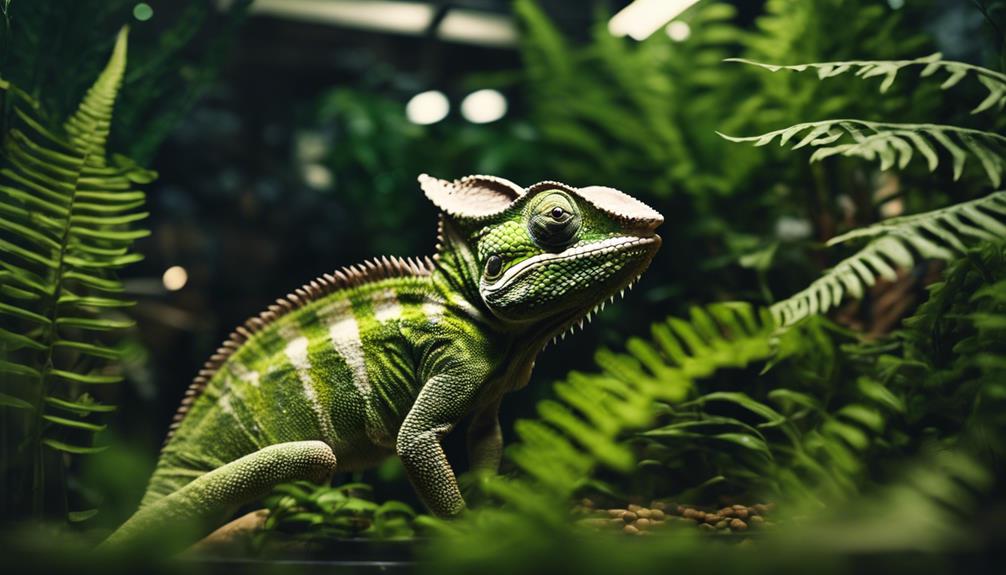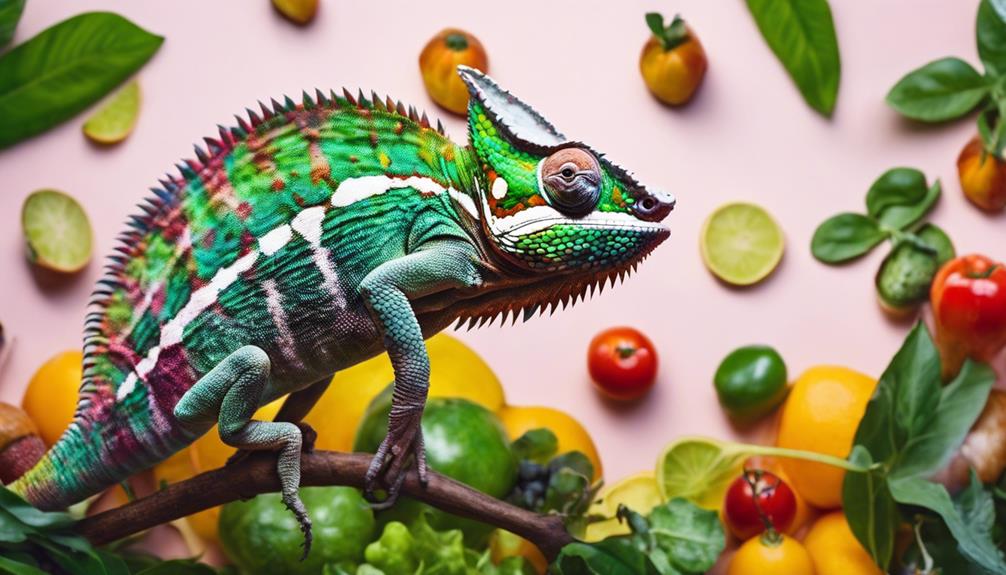Did you know that Boston ferns are not only aesthetically pleasing but also serve as a practical addition to your chameleon’s habitat? While ferns are generally considered safe for chameleons, there are some factors to take into account to guarantee the well-being of your reptile companion.
Understanding the benefits and potential risks associated with incorporating ferns into your chameleon’s environment is vital for maintaining a healthy and thriving habitat. Learn more about the specific advantages and precautions of using ferns to create an ideal space for your chameleon.
Yes, ferns are safe for chameleons and can be a good addition to their diet. They provide hiding spots and help maintain humidity in the enclosure.
Potential Benefits of Using Ferns
When considering the potential benefits of incorporating ferns into a chameleon’s habitat, Boston ferns stand out as a safe and advantageous choice for veiled chameleons. These plants not only provide a lush and natural environment but also help in maintaining the required humidity levels for veiled chameleons, essential for their health and well-being. Trusted sources like Chameleon Academy and Casqueabove recommend Boston ferns as suitable plants for chameleon enclosures, reflecting the consensus within the chameleon community regarding their benefits.
Veiled chameleons, in particular, enjoy and thrive with Boston ferns in their habitat, making them a popular choice among chameleon owners seeking to create a visually appealing and humidity-friendly environment for their reptiles. By incorporating Boston ferns into the chameleon enclosure, you aren’t only enhancing the aesthetic appeal but also contributing to the overall well-being of your veiled chameleons. So, when looking to create a comfortable and thriving habitat for your chameleons, Boston ferns prove to be a reliable and beneficial plant choice.
Risks Associated With Ferns
Certain fern species pose potential risks to chameleons due to the presence of toxic compounds that could be harmful if ingested. Chameleons, although not typically known to consume ferns, may accidentally ingest them while exploring their habitat.
The risk of toxicity from ferns varies depending on the specific species and the chameleon’s behavior. It’s vital to exercise caution and thoroughly research the fern species before introducing them to a chameleon’s habitat. Consulting with a veterinarian or an expert in chameleon care is advisable to guarantee the safety of your pet.
Remember that even if a fern species is generally safe for chameleons, individual chameleons may exhibit different behaviors that could increase the risks associated with certain plants. Prioritize your chameleon’s safety by being informed and proactive in selecting suitable ferns for their habitat.
Recommended Fern Species for Chameleons
To guarantee the well-being of your chameleon, selecting appropriate fern species is paramount, with Nephrolepis exaltata, commonly known as the Boston Fern, standing out as a safe and beneficial choice. Boston Ferns not only provide cover and a natural environment for chameleons but also play an important role in maintaining the required humidity levels in their habitat, promoting overall health.
Reputable sources such as Chameleon Academy and Casqueabove recommend Boston Ferns for chameleon enclosures due to their significant impact on the environment. Veiled chameleons particularly enjoy and thrive with Boston Ferns in their habitat, creating a lush and inviting space for these creatures. Proper care and maintenance of Boston Ferns are essential for their longevity, including tasks like regular watering and making sure adequate humidity levels are maintained to promote the health and well-being of your chameleon companion.
Proper Care and Maintenance of Ferns
Maintaining ideal humidity levels is essential for the proper care and maintenance of ferns in a chameleon habitat. To guarantee the health and longevity of your plants and chameleons, consider the following:
- Regular Watering: Adequate watering is essential to prevent ferns from drying out and wilting, which can have negative consequences for your chameleons.
- Monitoring Humidity Levels: Consistent monitoring of humidity levels is necessary to create a suitable environment for both your ferns and chameleons.
- Preventing Health Issues: Placing ferns in a dry location can lead to health issues in chameleons, emphasizing the importance of maintaining proper humidity levels.
Incorporating Ferns Into Chameleon Habitat
Incorporating ferns into a chameleon habitat not only enhances the aesthetic appeal but also plays an essential role in maintaining the required humidity levels for their well-being. Boston ferns, recommended by reputable sources like Chameleon Academy and Casqueabove, are safe and beneficial plants for veiled chameleons’ enclosures.
These ferns contribute to creating a lush environment that mimics their natural habitat, aiding in regulating humidity levels important for chameleons’ health. To guarantee the longevity and health of Boston ferns in a chameleon habitat, it’s important to practice regular watering and provide proper care.
These plants require adequate humidity to thrive, making them an ideal choice for chameleon habitats where moisture levels need to be maintained. Veiled chameleons particularly enjoy the presence of Boston ferns in their enclosure, further emphasizing the significance of incorporating these plants for the well-being of your chameleon.
Frequently Asked Questions
Can You Put a Fern in a Chameleon Cage?
You can put a fern in a chameleon cage. It enhances the habitat, aids in maintaining humidity, and promotes a healthy environment. Boston ferns are safe and recommended for veiled chameleons by experts.
What Plants Are Toxic to Chameleons?
Poisonous plants can harm chameleons, so it’s essential to know what’s toxic. Check your chameleon’s diet for risky foliage. Offer safe, edible greens like nontoxic options. Avoid dangerous shrubs for their well-being.
Can Chameleons Have Boston Ferns?
In your chameleon habitat, Boston ferns provide crucial humidity levels and a lush environment. They benefit chameleons’ health and well-being. Recommended by experts, these ferns enhance your pet’s living space, promoting their diet and behavior.
What Plants Are Good for Chameleons?
For your chameleon, vine plants like pothos and tropical leaves such as hibiscus offer climbing and hiding. Potted herbs like basil and hanging vines like spider plants provide variety. Incorporate moss terrariums, succulent gardens, and air plants for a diverse habitat.
Conclusion
To wrap up, as you weave the intricate tapestry of your chameleon’s habitat, remember that ferns are like the gentle rain that nourishes the soil of their home.
Just as the fern’s delicate fronds provide shelter and beauty, so too do they offer a sense of tranquility and harmony to your pet’s environment.
Embrace the verdant embrace of ferns, and watch as your chameleon thrives in the lush oasis you have created for them.


